Best Salmon Lures For Rivers: Secret Lures Used By Guides
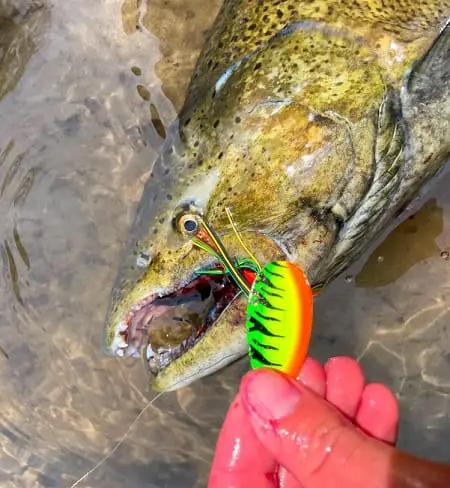
As a salmon fishing guide I use salmon lures to put my clients onto more fish when the salmon are in rivers.
Like many salmon guides, I know that lures are one of the most effective ways to catch salmon because they imitate baitfish or aggravate them to bite.
Not all lures are good for salmon, and some just consistently produce fish.
The three best salmon lures for rivers are the Kwikfish because of its enticing wobble, the in-line spinner because of the vibration and flash, and the crankbait because it closely resembles baitfish.
There are six other lures that can also be good for salmon fishing. I’ll also discuss the best sizes and colors, as well as which ones I use in different river conditions.
Quick Tips About Lures For Salmon
The best lures
- Kwickfish, MagLip, and Flatfish: 3 to 5 inches: Used when a slow wobbling lure is required, methods include back trolling, plunking, and casting with slow retrieve.
- Spinners: #3 to #6 blade size: Best for casting and back trolling
- Krocodile Spoon and Other Spoons: good for short and long-distance casts, 3 to 5 inch is best.
- Storm Thunderstick and Similar Cranbaits: Good in 4 to 6-inch sizes: used for casting and backtrolling.
- Use lures that have flash, action, and have a good vibration or sound to them.
- Change or use different lures, colors, and sizes based on different river conditions, the activity levels of the Salmon, and based on how the salmon responds to the lure.
- Choose lures in 3 to 5 inches lengths, in silver, black, and chartreuse will be a good start.
- Salmon like pink salmon and chum salmon prefer smaller lures, and they often love most lures as long as they’re pink.
GUIDE TIP: Watch for my guide tips throughout this article for tips on how to fish some of these lures better.
We may make a small commission from some of the links on this website, which is at no cost to you. I appreciate your support. Learn More
Best Rods And Reels For Casting Lures For Salmon
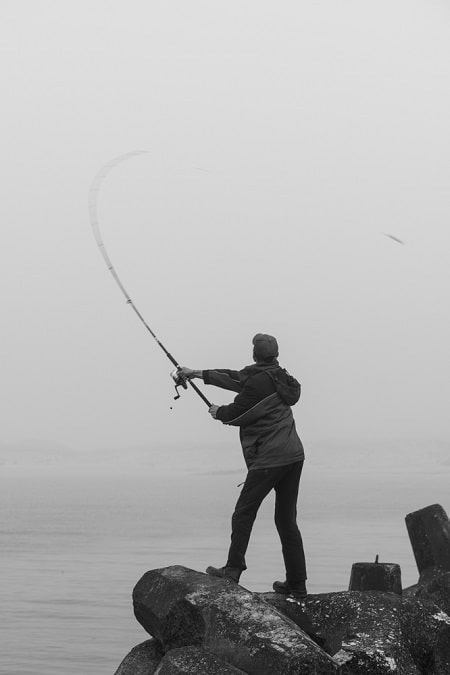
GUIDE TIP: Although you can use any 7-foot medium or heavy action rod when fishing lures for salmon, a rod that is longer and heavier will increase your casting distance.
A longer 8 or 9 foot medium-heavy to heavy action rod will provide more control over your presentation, and it will also make landing the salmon easier.
Any 3500 to 4500 spinning reel or baitcasting reel will work as long as it has a good smooth drag and can hold a lot of line.
Check out my page, Best Salmon Rods For River Fishing and Best Reels For Salmon Fishing In Rivers.
9 Lures For River Salmon
These are the nine best lures that I and my other guides use and the ones we found to be the most effective salmon lures when fishing rivers.
The Kwikfish Lure
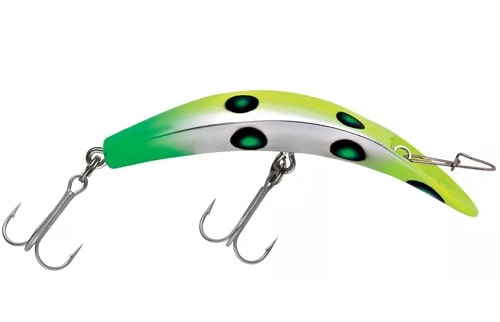
I was just talking to one of my guides about salmon fishing on a specific river, and he mentioned that when the salmon start to enter the river, he hits the bigger slower pools near the mouth with erratic lures like the Kwickfish.
I wasn’t really surprised by this because the Kwikfish lure has been one of my best salmon catching lures for about 20 years. It has caught a lot of salmon for my clients.
The reason this lure works so well is that it has a wide wobble, and it can be retrieved very slowly so that it dangles in the salmon’s face longer, which triggers hard aggressive strikes.
Some models, like the Kwikfish K Series, have rattles built into them that the salmon can hear from a longer distance. They literally hear or feel the vibrations before they see it.
I like the 4 to 5-inch Kwikfish for salmon fishing, and I find that the bigger sizes are best when the salmon have just entered the river, and the smaller sizes are better if the salmon are holding in clear pools or have been in the river for a couple of days.
In very clear water, when the salmon are holding and pressured, sometimes a smaller 3″ size will work best.
Guide Tip: I will sometimes speed up or rip the lure with an immediate pause for a second to trigger more strikes from less aggressive salmon. I do this about every 10 feet, and I will do this more often if the salmon don’t seem to be taking the lure on a straight steady retrieve.
In most water conditions, I do well with:
- Silver color: An all-around consistent producer.
- Flo Chartreuse/Green UV. A hot color in silver-green/chartreuse combination.
- Silver-blue can also be a good color in most water conditions.
- Flame Thrower: This is a secret color that has been hot for me over the last few seasons.
- Fickle Pickle: A great color for me in stained water, I tend to do good with darker colors like the Funky Chicken, black, and fluorescent red.
There are many other great colors for anglers to try because on some rivers other colors might work better. FishUSA.com has a big list of great Kwikfish colors.
Leave a comment in the comment section to let me and other readers know what works best for you. The Kwikfish is one of the top lures when back trolling for salmon and when back bouncing for salmon.
Yakima Mag Lip And Wardens Flatfish
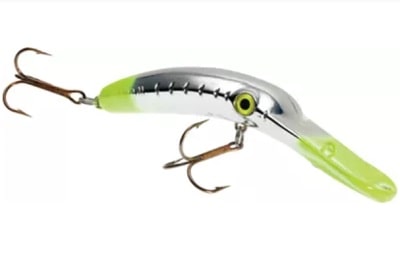
Almost identical to the Kwikfish fish is the Flatfish.
I mention these brands because they have some great colors that you can’t get with the Kwikfish, like the Flatfish in Fluorescent orange, Black Orange Spot, and the Pearch Scale.
These are all orange colors, and some days and on some rivers, the orange is hard to beat.
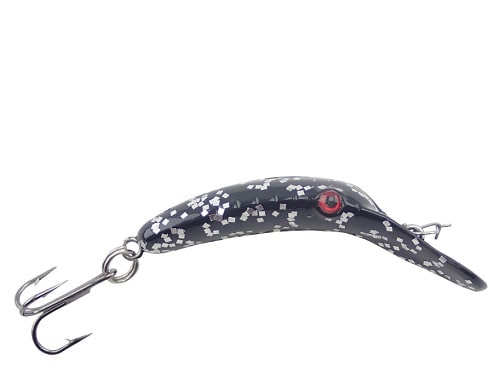
Many Salmon guides on the West Coast and in the Great Lakes regions love to use the lure called a Yakima Mag Lip.
The black speckle is also my most effective color for steelhead.
They also have the Yakima Bait Mag Lip, which can be good in slower, deeper water rivers and pools.
How To Fish Kwikfish And Flat Fish
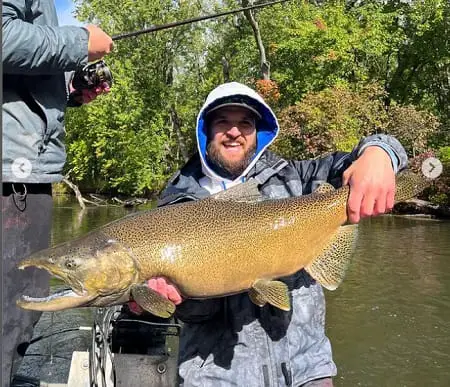
When you fish with Kwikfish or Flatfish you need to use a slow retrieve. It’s not that the salmon won’t hit a fast retrieve. This lure will not run properly if you retrieve it too fast.
A retrieve that is too fast can cause the lure to spin or even come up to the surface.
A nice steady, slow retrieve will keep the lure wobbling enticingly from side to side. Sometimes, just the current speed alone will make it wobble enough.
A combination of the current speed and the retrieve might cause it to spin and blow out, and if this is the case, just slow down your retrieve. The slower the current, the faster the retrieve can be.
I fish this lure the same way every time. I start at the top of the pool and cast across and slightly downriver, I lower my rod tip and make a super slow retrieve. In fast currents, I won’t retrieve or reel the handle at all. I simply cast across and then allow the lure to swing across the current and let the current give the lure the action.
Then I step down and repeat again and again until my lure has reached the bottom of the run.
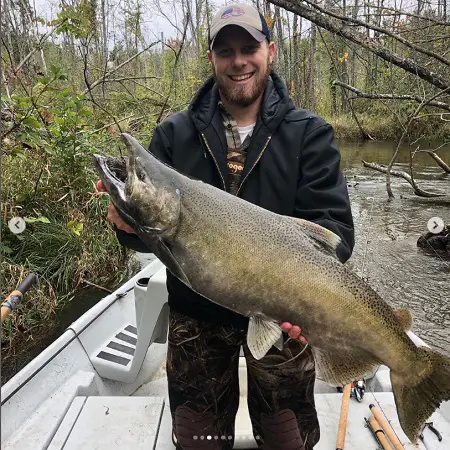
I cover the water systematically from the top of the pool to the bottom of the pool, casting about 2 to 3 feet down each time I cast again and allowing the lure to swing across the river. I use this method with almost all lures in moving water.
In really deep water, I will use some weight about 2 to 3 feet up the line just to get the bait into the salmon’s strike zone.
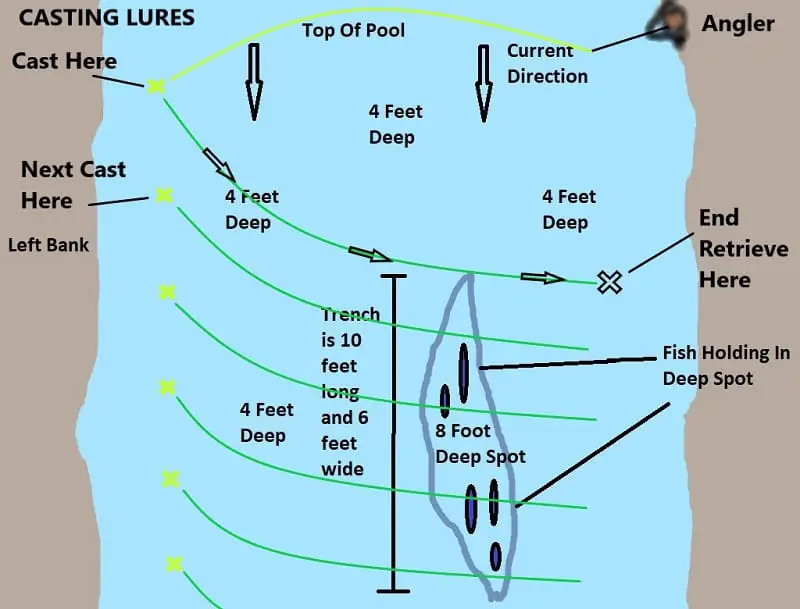
In-Line Spinners
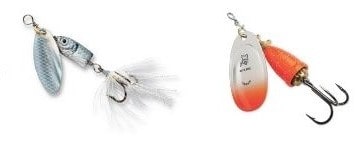
Inline spinners, also known as just spinners, are great lures for salmon in both slow and fast-water rivers.
Spinners are also excellent lures when fishing off the pier or the shore of the lake.
When using spinners for salmon, I like to cast across the rivers and start a slow retrieve, allowing the blades to spin as the spinner swings across the river.
For each cast, I will either cast about 3 feet further down or I will step down and cast straight across again. I usually keep my rod tip straight out and pointed in the direction of the lure, and I will keep it at about waist-high.
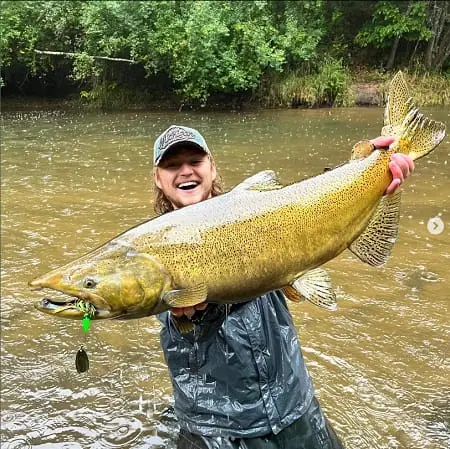
If I need less depth, I will cast on more of a downriver angle, or I will keep my rod tip higher. The higher your rod tip, the higher the spinner will be.
If I need more distance, I will either lower my rod tip close to the water’s surface, or I will cast more upriver and allow the lure a few seconds to sink before I start my retrieve and start the spinner swinging across the pool.
The longer you give the spinner time to sink, the deeper it will go. You will need to adjust this by how much you are hitting or snagging the bottom.
Some spinners will go deeper than others, and that depends on the weight of the spinner and the type or shape of the blade.
I try to always keep my spinner and almost all my lures 12 to 36 inches off the bottom.
Guide Tip: When covering the water, I will often make a cast with a nice steady retrieve and then I will make a second cast in the exact same spot, but this time I will use stop and go, rip-rip type of retrieve. I do the rip-rip about every 5 to 10 feet and follow that with a 1-second pause. I have seen the salmon ignore the straight, steady retrieve but then smash a rip-rip retrieve on the very next cast.
One of the best general-purpose spinners for fast, slow, deep, and shallow rivers is the Blue Fox Classic Vibrax – I will use the size 3 in shallow clear conditions and the sizes 4 and 5 for bigger water. This lure shines in shallow water because it will run shallow.

One of the reasons that I like this spinner more than a standard Mepps Aglia or other Mepps spinners is because I believe it has more vibration that seems to attract the salmon better. After years of heavy testing, I have found the Vibrax spinners to work the best.
My best colors for the salmon are glow green, glow chartreuse and the glow orange/pink. I also catch a lot of salmon and steelhead on the silver or silver shiner, Chartreuse Green Candyback, and Orange Candyback. There are a lot of other great colors.
In darker water, dirty water, and at night, I have had the most success with the solid black color as well as red.
If you fish deeper water for salmon and you want a spinner that will get deeper, use the Blue Fox Vibrax Bullet Spinner. Its thinner blade cuts through the water better for more depth. It’s also a good spinner if you want more speed. I use it the same sizes and colors as above.
Two other good spinners worth trying are the Blue Fox Vibrax Minnow Spin and the Panther Martin Spinner. The Panther Martins come in a ton of cool colors and is a hot seller in my tackle shop. Many anglers would swear by them.
For more info, check out my page, Spinner Fishing For Salmon: Guide Tips And Tactics.
Spoon Fishing For Salmon In Rivers

Spoons can be excellent if they are used properly and if you use the right ones. Boat anglers catch tons of salmon trolling with spoons, but once the salmon enter the rivers, anglers almost forget that spoons exist.
Most anglers simply cast them out and just reel them in, and that works sometimes, but the most effective way to fish them that I have found is to cast the lure across and allow it to sink to the bottom and then lift your rod tip with a slow retrieve. I lift the rod tip only high enough that the spoon will hit the bottom every few feet.
Each time the spoon hits the bottom, I quickly lift the tip to make the spoon jump up off the bottom about 2 to 3 feet and then lower the rod tip again with a slow retrieve to allow it to bump the bottom again, and keep repeating this from the far bank to the close bank. Then move or cast down 3 feet and do it again.
When I use spoons for salmon, I will often add a strong high-quality swivel. I will use a size 3 or 4 snap swivel from Owner or a size 6 Spro or VMC Snap Swivels.
Not all spoons are good for river fishing. Many salmon spoons are designed to be trolled and are too light for casting. Use spoons that are known to be good for casting and river fishing, like the ones below.
When fishing bigger rivers, I like spoons in the 3 to 4.5-inch size, and when fishing small to medium-sized clear rivers, I find that 2.5 to 3.5-inch spoons often work better, especially with salmon they are spooked.
My favorite spoons and most effective colors when salmon fishing in rivers are:
Luhr Jensen Krocodile Spoon
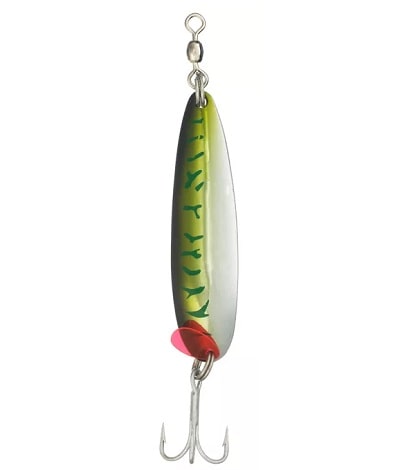
Krocodile Spoon – This is my favorite salmon spoon for spoon jigging. It is good in faster, bigger rivers or in a smaller clear river in the 3 to 4.25 sizes, but I might use the 2 11/16 inch or 2 5/8 inch when fishing small clear rivers.
The colors that work best for me are:
- Chrome-Silver Prism Lite, Hammered Brass-Fire, Metallic Perch, Chrome Green Mackerel, Chrome/Flo., Green Prism-Lite, and Blue Mackerel.
ACME Tackle Little Cleo Spoon
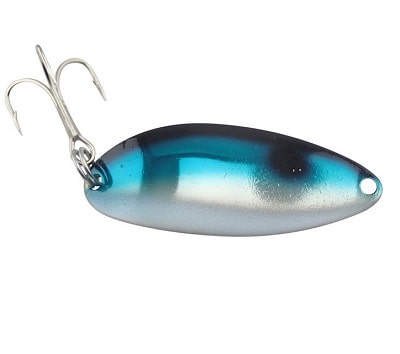
Acme Little Cleo Spoons – The 2/5 oz is my go-to size, and this spoon can cast a mile. I will also use the and the 3/4 on bigger rivers or aggressive salmon.
I have done well with the colors Hammered green/gold, hammered green/silver, and hammered blue/silver, and gold/orange. Melo-Yellow, and the Green Digger have been very good.
If you are new to this lure, check out this Acme Little Cleo Classics Kit – 3/4 oz. – 4 Assorted packs, which have great colors for salmon.
Original Doctor Spoon – This has been a productive spoon for casting salmon in rivers, and it comes in a lot of great colors, including the Chartreuse that is hard to find in the other spoons.
Two other spoons that I use and like are the Eppinger Daredevil spoons and the Mepps Syclops Spoon.
For more on my most effective tactics and tips, check out how to fish spoon for salmon.
Crank Baits For Salmon Fishing
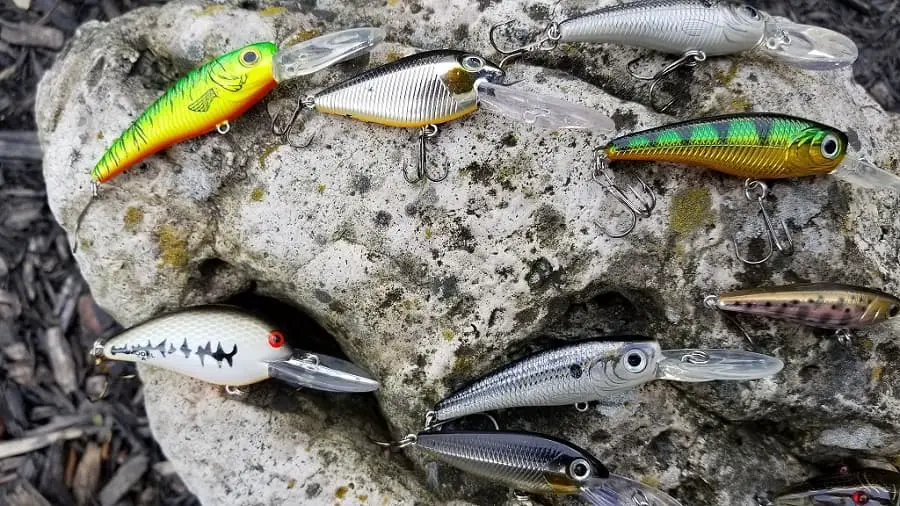
Many river guides and I like to use crankbaits for fresh running salmon, especially in the lower ends of the rivers. I often use a rip-rip retrieve mixed with 10 feet of steady retrieve, then a rip or two and a pause.
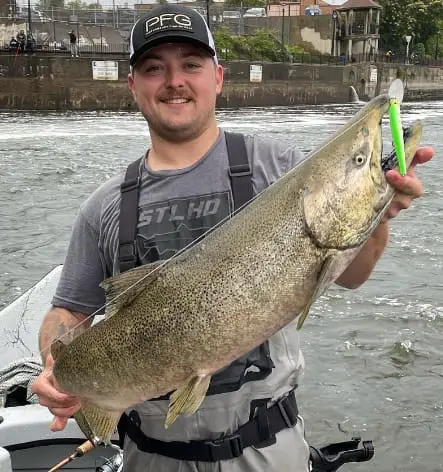
Often, the more erratic the retrieve, the better. This can often trigger really aggressive strikes.
When fishing for salmon, I like my crankbaits to be between 3 and 5 inches long. There are times when a 6-inch crankbait will work better, so it’s a good idea to have a good selection on hand.
Kelly from Northern Michigan Custom Rod and Guide Service says the “Thunderstick is top crankbait for Kings.”
I also like the deep-diving Storm Deep ThunderStick MadFlash models, and based on his pictures, he prefers the Chartreuse or brighter colors like the Luminous Green Herringbone
Other crankbaits like 3-inch Cotton Cordell Big O Crankbait in Chartreuse or silvers have been hot for me when fishing for salmon. I will use this in water 10 feet or less.
A guide secret lure is the Brad’s Wiggler and Brad’s Magnum Wigglers. These are used by a lot of West Coast and Great Lakes Salmon and steelhead guides.
This is often the go-to lure when side-drifting and back-trolling. Add a chuck of cured shrimp to entice more bites. See Salmon fishing with shrimp.
When I need to get deeper and when I want to bounce my crankbait off the rocks a few times, I like the 3.25-inch Cotton Cordell Wally Diver in chartreuse, orange, silver/black, silver/blue.
Another good choice for getting deeper is the Rapala Down Deep Husky Jerk or the Rapala Shad Rap SR09 Hard Bait.
The Rapala Original and Rapala Original jointed are also great for salmon.
Check out my Crankbait Fishing For Salmon page for my most effective presentation methods for crankbaits.
Jigs For Salmon Fishing
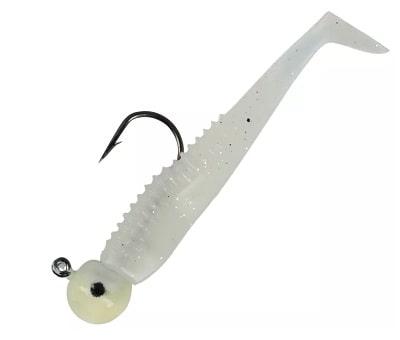
Jigs fishing for salmon can be very effective, which makes jigs one of the best salmon baits.
What I like about jigs is that you can use heavier ones for bigger, deeper, and faster rivers and smaller ones for the smaller salmon creeks and rivers.
When I talk about jigs for salmon, I’m not talking about the type that you use when float fishing for salmon. I’m talking about jigs that you can cast.
I will try to cover the water the same way as with most lures. This means covering the water from the top down.
With jig fishing, you can jig them in an up-and-down motion, you can twitch and rip them. I have also seen guys use large paddle tail jigs and reel them in like crankbaits, with a few rips and twitches along the way.
Salmon Jig Size
I cast them across the same way that I do with other lures and jig them up and down as they swing across the pool. To do this, the jigs need to be a good size and weight.
I have done well with Three and 4-inch jigs and the same colors that work. The 3/8-ounce, 1/2-ounce jigs are my go-to weight, but I will upsize for longer casts or faster water.
Twitching jigs like the Hawken Marabou Series AeroJig are great for twitching through pools, and they come in lots of colors.
Jig Colors For Salmon
I use the same bright colors that I use when crankbait fishing, but I have found on nervous fish, or fishing in smaller rivers and when salmon are holding in pools that blacks and olives can often be a better choice
Some jigs that have worked well for me when salmon fishing are the:
- Booyah Baits Mobster Swim Jig – I have done well with black, but have crushed them with white, and even had good days with chartreuse colors.
- Strike King KVD Swim Jig in the largest size is another good option when jig fishing for salmon.
- Three or 4-inch twister tail and paddle tail jigs on a standard 1/4oz jig head are good jigs to try when fishing for salmon.
- Gary Yamamoto Zako Paddletail Swimbait – 4” – Chartreuse Shad on a large 1/2 or 3/4 oz jighead can be deadly.
Although casting lures can be a great method, there are other methods that I use when fishing for salmon. You can see the best ways to fish for salmon on my page Fishing For Salmon In Great Lakes Rivers
Tight Lines
Graham

))/1027088.json)
))/2188149.json)
))/2278542.json)
))/2840174.json)
Nice article as usual Graham,
I was wondering how effective would swinging a texas rigged 3-4inch paddle tail soft plastic be in waters were you would usually swing a fly ?
I have also found some weedless soft plastic soft vibe baits similar to a rattle trap but more subtle vibrations and weedless as well and are less than 10cm,
http://www.wilsonfishing.com/Products/Lures/Zerek-Innovation-Lures/Fish-Trap-Weedless
I wanted to know your thoughts on it, as fishing such lures could avoid the whole issue of snagging fish .
Hey Durvesh,
I can’t say that I have tried that, however, I have caught plenty of steelhead and salmon swinging flies so I don’t see why a paddle tail wouldn’t work for them. I’ve also caught or had my clients catch a bunch of steelhead by letting their pink and red worms swing at the end of a drift under a float. The 4″ Mad River Steelhead worms are the best for that.